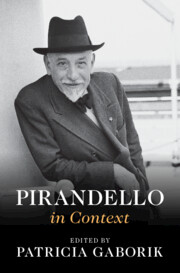Book contents
- Pirandello in Context
- Pirandello in Context
- Copyright page
- Dedication
- Contents
- Figures
- Contributors
- Preface
- Acknowledgments
- Chronology
- List of Cited Titles in Translation and the Original Italian
- Part I Places
- Part II Institutions
- Part III Interlocutors
- Part IV Traditions and Trends, Techniques and Forms
- Part V Culture and Society
- Chapter 25 History
- Chapter 26 Celebrity
- Chapter 27 Cinema
- Chapter 28 Modernity
- Chapter 29 Fascism
- Chapter 30 Women
- Chapter 31 Religion
- Chapter 32 Madness
- Chapter 33 Suicide
- Part VI Reception and Legacy
- Further Reading
- Index
Chapter 28 - Modernity
from Part V - Culture and Society
Published online by Cambridge University Press: 14 March 2024
- Pirandello in Context
- Pirandello in Context
- Copyright page
- Dedication
- Contents
- Figures
- Contributors
- Preface
- Acknowledgments
- Chronology
- List of Cited Titles in Translation and the Original Italian
- Part I Places
- Part II Institutions
- Part III Interlocutors
- Part IV Traditions and Trends, Techniques and Forms
- Part V Culture and Society
- Chapter 25 History
- Chapter 26 Celebrity
- Chapter 27 Cinema
- Chapter 28 Modernity
- Chapter 29 Fascism
- Chapter 30 Women
- Chapter 31 Religion
- Chapter 32 Madness
- Chapter 33 Suicide
- Part VI Reception and Legacy
- Further Reading
- Index
Summary
Pirandello is one of the most famous and important cultural figures of Italian modernism, and his work is deeply invested in responding to the rapidly changing forces of modernization. This chapter examines his complex relationship with modernity through a comparison to the Italian avant-garde movement of Futurism: Where the Futurists were focused on using their cultural production to usher in and intensify processes of technological modernization, Pirandello’s stance is more complex and ambivalent. The chapter thus traces their responses to a shared set of cultural conditions, spanning from a shared rejection of scientific materialism and positivism to engagement with new models of sociology, psychology, and philosophy, and finally considers their divergent views of cinema and the promise of technology to transform the future.
- Type
- Chapter
- Information
- Pirandello in Context , pp. 227 - 234Publisher: Cambridge University PressPrint publication year: 2024

